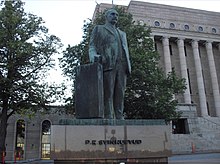Pehr Evind Svinhufvud

Pehr Evind Svinhufvud [ pæːr ˈeːvind ˈsviːnhʉːvɵd ], (born December 15, 1861 in Sääksmäki, † February 29, 1944 in Luumäki ), with the full noble name Svinhufvud af Qvalstad , was a Finnish politician and statesman .
Origin and youth
The noble family of Svinhufvud (the name literally means "pig's head" or rather "boar's head" in Swedish ) originally comes from Dalarna in Sweden .
Pehr Evind Svinhufvud was born on December 15, 1861 in Sääksmäki in the southern Finnish region of Häme . His parents were Pehr Gustaf Svinhufvud and Olga von Becker. The father was a sea captain and drowned in Greece at the age of 27 when the son was only two years old. As a result, Pehr Evind Svinhufvud spent his early childhood in the house of his grandfather Pehr Gustaf Svinhufvud, provincial treasurer and landowner of Rapola in the Sääksmäki district (western Finland). The estate was forcibly auctioned off - the grandfather shot himself. Before starting school, his mother moved to Helsinki with Pehr Evind and his sister, who was one year older .
Career
In Helsinki, Svinhufvud became a lawyer and represented his family, who had been ennobled in 1574, in the knights' chamber of the old state parliament. From 1907 to 1914 he was a Conservative MP for the Young Finnish Party in the new one-chamber Reichstag and its spokesman until 1912. As an opponent of the Tsarist regime , he was deported to Siberia in 1914 . In 1917 Svinhufvud was President of the Senate and traveled to Petrograd in order to obtain the recognition of Finland's independence from Lenin , which also succeeded. During the Finnish Civil War he was at the head of the White Government in Vaasa / Turku and was temporarily head of state from May to December 1918. After the defeat of the Central Powers in World War I, he was no longer sustainable as a monarchist and friend of the Germans and was taken over by Gustaf Mannerheim replaced. In 1930 the Lappo movement forced his appointment as Minister of State and in 1931 he was elected President. The right-wing conservative Svinhufvud did not want the Social Democrats to participate in government . In the 1937 presidential election he was defeated by the Landbund candidate Kyösti Kallio in the second ballot.
family

His wife was from 1889 until his death in 1944 Alma Ellen Timgren (1869-1953), daughter of Gustaf Werner Timgren and Alma Sofia Malvina Svinhufvud.
Their children were
- Pehr Yngve (1890–1991), master of law;
- Ilmo Gretel (married Sommar) (1892-1969);
- Aino Mary (married Alfthan), (1893–1980), dentist;
- Eino Gustaf (1896–1938), Doctor of Philosophy;
- Arne Bertel (1904-1942);
- Veikko Eivind (1908–1969), forest clerk, member of parliament.
Pehr Evind Svinhufvud died on February 29, 1944 in Luumäki in Kymi Province . His larger than life monument stands in front of the Finnish Parliament building in Helsinki.
See also
literature
- Erkki Raikkönen: Suuri juhlapäivä: onnittelut ja kunnianosoitukset tasavallan presidentin PE Svinhufvudin tayttäessä 70 vuotta . Helsinki 1932 (German by Rita Öhquist : Svinhufvud builds Finland , Munich 1936)
- Svenska uppslagsboken . Malmo 1927-1937
Web links
- Literature by and about Pehr Evind Svinhufvud in the catalog of the German National Library
- Newspaper article about Pehr Evind Svinhufvud in the 20th century press kit of the ZBW - Leibniz Information Center for Economics .
- Svinhufvud, Pehr Evind (1861-1944) . In: National Biography of Finland (English) full biography
- Seppo Tihonen: The Finnish Presidency as an Institution. ( Memento of July 3, 2007 in the Internet Archive ) 1999
Individual evidence
- ↑ Svinhufvud i Westergötland ( Memento from September 12, 2005 in the Internet Archive ) svenskadel.nu
- ↑ a b c Biografiakeskus - Svinhufvud, Pehr Evind (1861–1944). kansallisbiografia.fi
| personal data | |
|---|---|
| SURNAME | Svinhufvud, Pehr Evind |
| BRIEF DESCRIPTION | Finnish politician, member of the Reichstag and President (1931–1937) |
| DATE OF BIRTH | December 15, 1861 |
| PLACE OF BIRTH | Sääksmäki |
| DATE OF DEATH | February 29, 1944 |
| Place of death | Luumäki |



